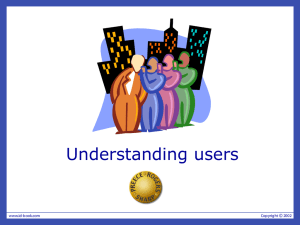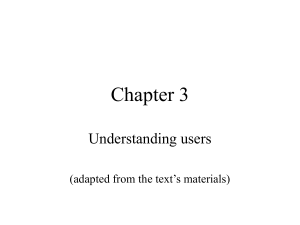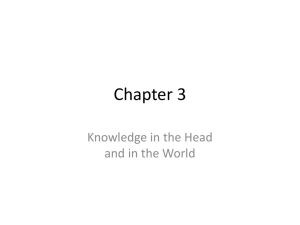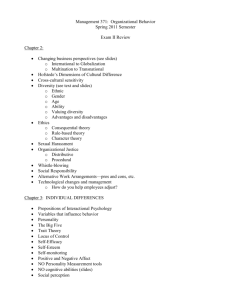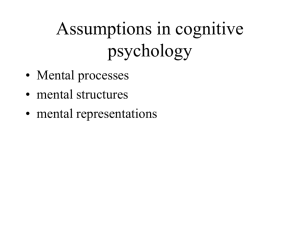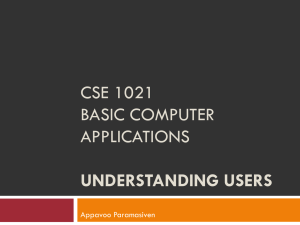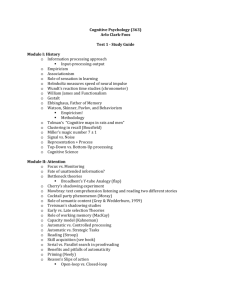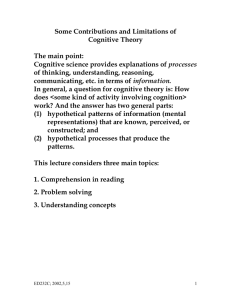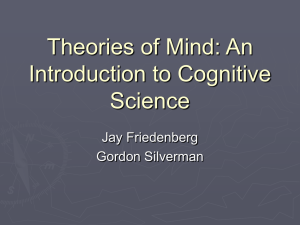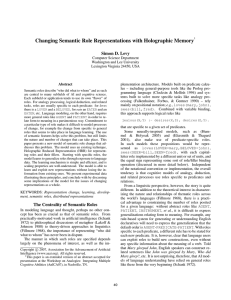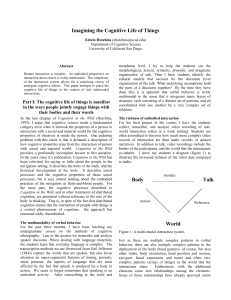ppt
advertisement
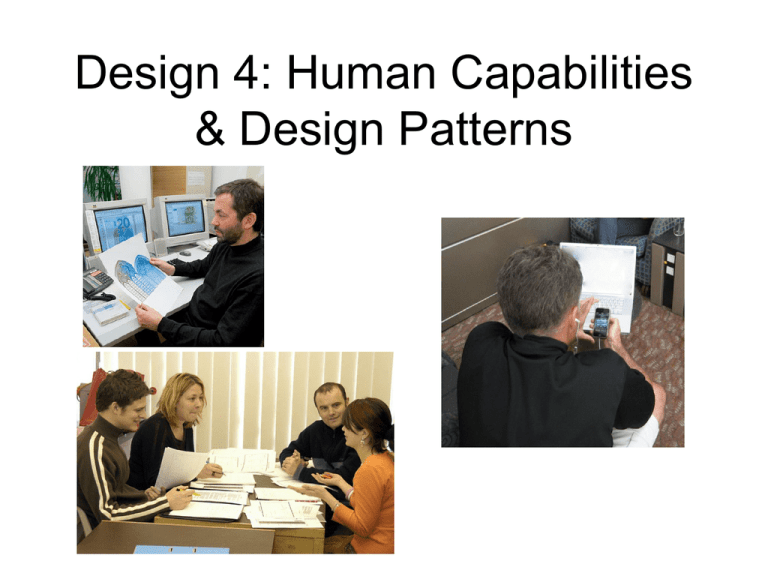
Design 4: Human Capabilities & Design Patterns Objectives By the end of this class, you will be able to… • Explain several design guidelines based on human capabilities • Apply the guidelines to design & critique user interfaces 2 1. Bringing cognitive What goes on in the mind? psychology knowledge to HCI perceiving.. thinking.. remembering.. learning.. planning a meal imagining a trip painting writing composing 3 3 understanding others talking with others manipulating others making decisions solving problems daydreaming... Core cognitive aspects • Attention • Perception and recognition • Memory • Reading, speaking and listening • Problem-solving, planning, reasoning and decision-making, learning Here we focus on the first 3, plus a bit about reasoning / problem solving 4 Attention • Selecting things to concentrate on • Can be focused or divided • Spotlight model: visual attention is like a spotlight directed towards targets 5 Attention • We are more likely to notice something if – We are attending to it – It is salient (bright, loud, or otherwise noticeable) • We have a limited ability to keep track of events (limited number of spotlights) 6 Change Blindness • We can LOOK but not SEE – E.g. drivers running into pedestrians • To see something, we need to attend to it • A ‘mud splash’ or other disruption can make changes especially hard to see Attention: Design implications • Make information stand out when it needs attending to or is important – Use colour, ordering, spacing, underlining, sequencing and animation • Avoid cluttering the interface - follow google.com example of crisp, simple design – Group features together – Show icons for group headings and commonly used functions – Allow users to customize 8 Too many icons Over-use of graphics 10 Clean, simple design Perception and recognition • How information is acquired from the world and transformed into experiences • Obvious implication is to design representations that are readily perceivable, e.g. – Text should be legible – Icons should be easy to distinguish and read – Information should be organized • We discussed perception quite a lot last lecture (e.g. colour perception, 12 grouping) Perceptual Grouping • We group objects that are… Close to each other (proximity) 13 Similar Connected Memory • Involves encoding and recalling knowledge – Short term and long term – We don’t remember everything - involves filtering and processing • Context affects memory • Recognition easier than recall – Benefit of GUI over command-based interfaces • We are better at remembering… – Images rather than words – Familiar things 14 Example: Setting a Font • Type in font name: – Hard to remember Menus gone crazy! 16 Better choice Memory Excercise • Int heb ack oft heb oxi sat oy • In the back of the box is a toy 18 Classic ‘72’ • George Miller’s theory of how much information people can remember – 72 chunks of information (e.g. 7 digit phone numbers) – Short-term memory • People’s immediate memory capacity is very limited • Useful finding for interaction design? 19 What some designers get up to… • • • • • Present only 7 options on a menu Display only 7 icons on a tool bar Have no more than 7 bullets in a list Place only 7 items on a pull down menu Place only 7 tabs on the top of a website page – But this is wrong? Why? 20 Why? • Inappropriate application of the theory • People can scan lists of bullets, tabs, menu items till they see the one they want – They don’t have to recall them from memory • Often a small number of items is good design • But it depends on task and available screen estate 21 More appropriate application of memory research • File management and retrieval is a real problem to most users • Memory involves 2 processes – recall-directed and recognition-based scanning • File management systems should be designed to optimize both kinds of memory processes 22 Properties / functions of a good file browser? • Facilitate existing memory strategies and try to assist users when they get stuck – Flexible search (partial name, date, type, suggest alternates…) – Enable file browsing • Help users encode files in richer ways – Provide them with ways of saving files using colour, flagging, image, flexible text, time stamping, etc 23 Mental models • Users develop an understanding of a system through learning & using it • Knowledge is often described as a mental model – How to use the system (what to do next) – What to do with unfamiliar systems or unexpected situations (how the system works) • People make inferences using mental models of how to carry out tasks 24 Exercise: ATMs • Write down how an ATM works – How much money are you allowed to take out? – What denominations? – If you went to another machine and tried the same what would happen? – What information is on the strip on your card? How is this used? – What happens if you enter the wrong number? – Why are there pauses between the steps of a transaction? What happens if you try to type during them? – Why does the card stay inside the machine? – Do you count the money? Why? 25 How did you fare? • Your mental model – How accurate? – How similar? – How shallow? • Payne (1991) did a similar study and found that people frequently resort to analogies to explain how they work • People’s accounts greatly varied and were often ad hoc 26 User & Design Models • User model – a user’s conceptual model • Design model – a designer’s conceptual model • How is the design model conveyed to the user? – Through the system image (interface) The design principle of transparency • NOT to be understood as literal • useful feedback • easy to understand • intuitive to use • clear & easy to follow instructions • appropriate online help • context sensitive guidance of how to proceed when stuck 28 Make the system model visible through the interface. Why? • Experiment by Halasz & Moran: – Task: solve problems using a ‘stack calculator’ – 2 groups of participants: both groups were taught step-by-step procedures – One group was also given a model of how the calculator works – Both groups did well on routine problems, but the group with the model did better on novel problems 29 External cognition • Concerned with explaining how we interact with external representations (e.g. maps, notes, diagrams) • Q: How do maps / notes / diagrams help us? Why not just keep them in our head? Think of some examples. 30 Externalizing to reduce memory load • Diaries, reminders, calendars, notes, shopping lists, to-do lists, Post-its, piles, marked emails • Location may indicate priority & type of reminder • External representations: – Remind us that we need to do something (e.g. to buy something for Father’s day) – Remind us of what to do (e.g. buy a card) – Remind us when to do something (e.g. send a card by a certain date) 31 Computational offloading • When a tool is used in conjunction with an external representation to carry out a computation (e.g. pen and paper) • Try doing the two sums below (a) in your head, (b) on a piece of paper and c) with a calculator. – 234 x 456 =?? – CCXXXIIII x CCCCXXXXXVI = ??? • Which is easiest and why? Both are identical sums 32 Annotation and cognitive tracing • Annotation involves modifying existing representations through making marks – e.g. crossing off, ticking, underlining • Cognitive tracing involves externally manipulating items into different orders or structures – e.g. playing scrabble, playing cards 33 Design implication • Provide external representations at the interface that reduce memory load and facilitate computational offloading » e.g. Information visualizations have been designed to allow people to make sense and rapid decisions about masses of data » Offload cognitive operations to the perceptual system 34 Interface Design Patterns • Many interface problems crop up again and again • Use existing patterns when possible – E.g. http://www.cs.helsinki.fi/u/salaakso/pattern s/index.html Key Points • When designing interfaces… – Support recognition rather than recall – Make important items stand out from the rest – Make system functionality transparent, via the interface – Represent information visually so the user does not need to remember it or think about it, they can just see it – Re-use existing interface design patterns 36
